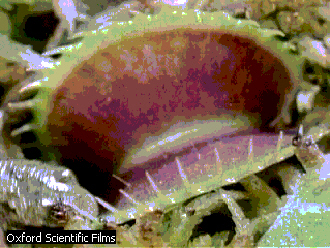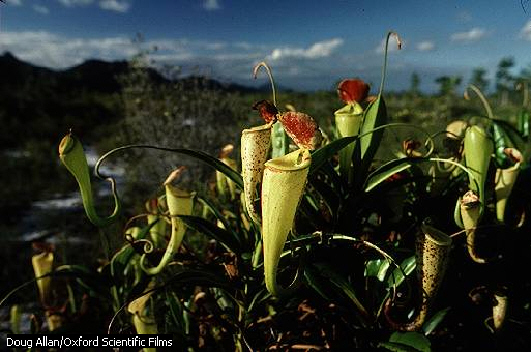 almost
inevitably limited to small insects.
almost
inevitably limited to small insects.
Insectivorous plants and carnivorous plants are plants that gain some
of their nutrition from animals, especially insects, captured by the
plants themselves. Most grow in bogs where the soil is acid and poor
in available nitrogen; capturing insects is one way of getting
nitrogenous compounds without manufacturing them. At the same time,
the green leaves of these plants manufacture carbohydrates. The
trapping mechanism of insectivorous plants is relatively small.
Therefore, prey is  almost
inevitably limited to small insects.
almost
inevitably limited to small insects.
Insectivorous plants are diverse, however, a majority are in the order of the pitcher plant, sundews and the Venus's-flytrap, and East Indian pitcher plants. Others include the bladderworts, butterworts, and the Australian pitcher plant. Certain species of fungus are known to be carnivorous as well.
VENUS'-FLYTRAP
Venus' flytrap is the common name for a plant that feeds on insects and other small animals, native to North and South Carolina. The plant, found in or near bogs, grows to a height of about 12 inches. Its flowers are small and white. The lower portion of the leaves, next to the stalk on which the flowers grow, is bladelike. The outer portion of each leaf is modified to form a trap. It is divided into two halves, with margins bearing long, sharp spines. At the center of the leaf are trigger hairs to spring the trap. When an insect or other creature, attracted by sweet fluids exuded by the plant, lands on this portion of the leaf, it touches the trigger hairs. The leaf snaps shut around its prey, and the spines keep the prey from escaping. When glands within the leaf have digested the soft tissues of the creature, the leaf reopens.
SUNDEWS
The sundews include about 90 to 100 species of mainly perennial herbs. Found worldwide, they are among the most common of insectivorous plants. The small white, pink, or purple flowers grow alone or in one-sided clusters. The leaves form small rosettes on the ground in bog areas; the upper surface of each leaf is covered with prominent, gland-tipped, green to reddish hairs. The glands excrete a clear, sticky fluid that clings to them like dewdrops; the name sundew is taken from these drops, as they are not dried up by the sunlight. If a small insect alights on the leaf or brushes past it, it is held fast by the sticky hairs, which curve inward and press the victim down onto the surface of the blade, where it is digested.
BLADDERWORTS
The bladderworts make up about five genera of widely distributed herbs. The most widespread genus contains about 275 species found in temperate and tropical regions throughout the world. Some species of this genus are aquatic and others terrestrial. Several tropical species are air plants resembling orchids. Among the aquatic bladderworts, some root in the mud; others, such as the common bladderwort, are rootless, floating freely in ponds. The common and scientific names of the genus refer to the many bladders borne on the leaves of the common bladderwort.
The bladders of the common bladderwort range up to 1\5 inch in diameter. Each has an orifice that is guarded by bristles. When tiny aquatic insects or other animals, including minute fish, touch these bristles, the bladder suddenly dilates, sucking in and trapping the animal. By digesting its prey, the bladderwort obtains the food that plants normally get through a root system.
 PITCHER
PLANTS
PITCHER
PLANTS
Pitcher Plant, common name for three families of flowering plants that have leaves modified as pitchers for trapping and digesting insects. The entire leaves of all these plants are tubular and hollow and lined with downward-pointing hairs. When an insect enters, it cannot climb back out against the hairs and ultimately falls to the bottom of the leaf, to be digested by juices contained there. Pitcher plants typically occur in poor soils and depend partly on nutrients obtained from the digested insects.
The most common pitcher plant is the California pitcher plant, native to northern California and the coastal Pacific Northwest. The family of East Indian pitcher plants contains only one genus of about 75 species, found in tropical Asia. The family of Australian pitcher plants contains a single species, which is native to Australia.
Contributed By:
Marshall R. Crosby
FURTHER READING
Slack, Adrian. Carnivorous Plants. MIT, 1980. State Mutual, 1982. How 50 worldwide species entice, catch, and digest their prey; beautiful illustrations.